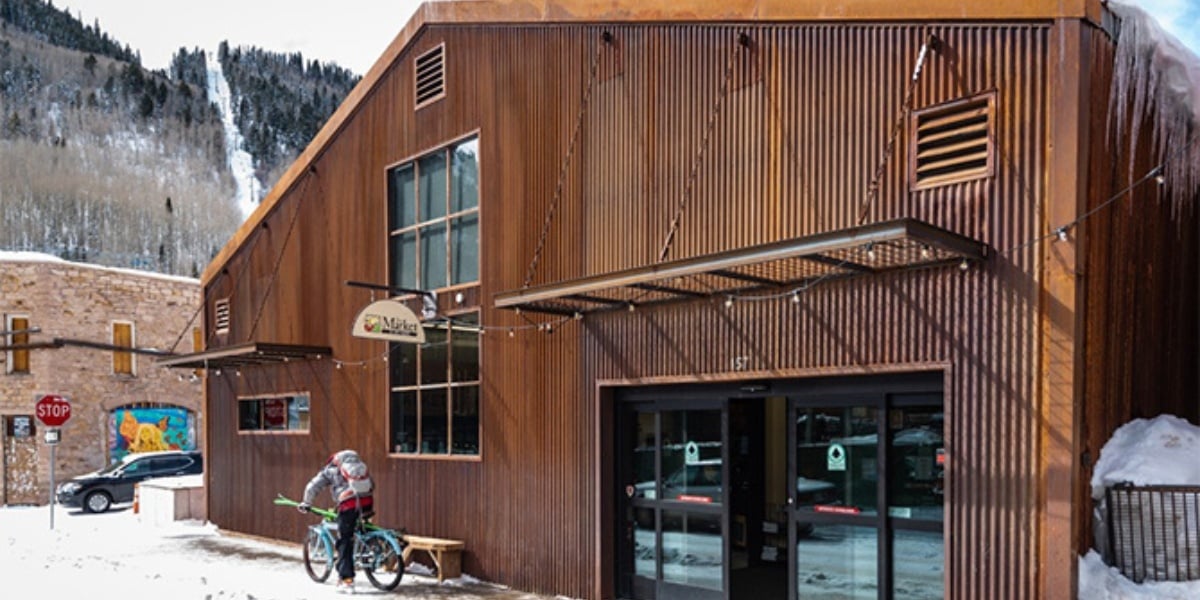Help Isom IGA recover from devasting floods

5 min read
From 0-25: How Darin Hill has Grown a Grocery, Liquor, and Hardware Empire
Written by Carlie Wagner
May 22, 2024
Just a couple years after purchasing his first grocery store in Ridgway, Colorado, Darin Hill heard that a developer was looking at the area as a potential site for a new store. Concerned that it would affect his market share, Hill decided to jump all in and purchase a second store himself. Growing and diversifying, he believed, would be the key to helping him better weather threats from competitors.
Little did he know that, in just over 20 years, these two stores would balloon into 17 grocery stores, as well as hardware and liquor stores, for a total of 25 stores across Colorado, Arizona, Minnesota, Montana, Nevada, Wisconsin, and Wyoming.
The Market Difference
Hill’s grocery career started when he was just 14 years old in Casper, Wyoming, where he got his first job bagging groceries. Although he moved to the corporate side of grocery for a few years, he never left the industry. By 2000, Hill was ready to take all the knowledge he had accumulated and go out on his own.
Branded as “The Market,” Hill’s collection of stores offers cohesive branding and a family-owned, neighborhood feel. Yet, each store is strategically differentiated to best fit the needs and character of its local community.
Some of the differences from store to store are purely a result of the size and layouts of the buildings themselves. Ranging from 4,000 to 50,000 feet, the stores necessarily must adjust to their footprints.
But the differences in character extend far beyond simple store layout. In ski towns like Telluride and Vail, Colorado, for example, the shoppers tend to be higher-end tourists that are looking for more gourmet, upscale, organic options.
 Longfellow Market in Minneapolis, Minnesota
Longfellow Market in Minneapolis, Minnesota
Each store also has its own look and feel - Longfellow Market in Minneapolis, Minnesota, one of the few The Market stores located in a large city, has a wall of glass at the front of the store, while Heber, Arizona, a town of just under 3,000, has rustic wood ceilings.
Regardless of location, each store includes a distinct mix of national and global favorites paired with locally produced options. These same local touches can be found in Hill’s other businesses.
 Wood beams are an architectural feature of The Market store in Heber, Arizona
Wood beams are an architectural feature of The Market store in Heber, Arizona
Keys to Expansion
With any new business, there have been challenges along the way, but Hill has figured out important techniques and best practices to help him continue to grow and expand.
Invest in People
His first recommendation when adding stores?
“Get great people,” Hill said. Even though hiring, especially post-pandemic, can be difficult, Hill stressed, “Paying for talent — especially in management — is an important investment. If you can’t be at the store all the time, you need to feel confident that you have somebody who really cares that the store is doing well and is able to efficiently manage the day-to-day operations.”
Of course, great employees are also their own rewards. When asked what he likes most about the grocery business, Hill didn’t hesitate.
“The opportunity to interact with so many wonderful people, from customers to employees,” Hill said.
Research is Crucial
Another best practice?
“Do as much research as possible before the purchase,” Hill said, noting that purchasing an existing store has less risk. “You don’t have to drill a well and hope to hit oil.”
Instead, he said you can go through reams of data about past performance, profitability, etc.
However, because his stores are in the western portion of the country, where there is more space between communities and fewer existing stores for sale, this is often not possible. As a result, Hill has also become highly attuned to knowing what will and will not succeed before building a new store. Without the luxury of past performance, Hill said he relies on information about the community, population growth, and other related factors.
It’s also important to be flexible. Hill originally expanded into hardware and liquor because they were tied to the grocery business.
Dive into Data
It’s not just in choosing new locations that data is king. Data is vital to keeping track of store performance across geographies, distributors, and store types.
“We have indicators in the data — Where are we growing? Where are we lagging?” Hill explained.
He said keeping on top of the numbers helps drive smart decisions, even when you can’t be physically on the ground.
Asked about his biggest challenge, Hill explained that it is data integrity. With so many distributors across various business types, it can be quite complex to bring all that data together and really see what you have. Then, once it is aggregated, there is another step to ensure that the data is correct.
Hill is always looking for new strategies to ensure that he has the best tools available to understand the story the data is telling. But the extra effort to clean and interpret data has been worth it, he said, as it helps him keep a good eye on his brand performance from anywhere.
Think Outside the Box
One of the unique challenges of running The Markets is that they are geographically spread apart. The Longfellow, Minnesota store, for example, is about 1,200 miles — or a whopping 19-hour drive — from his Telluride, Colorado store. Of course, this means that Hill can’t just jump in the car and head to a specific store on any given day.
To overcome this obstacle, The Markets invested in a corporate plane so that Hill can move from place to place far more efficiently. Now, instead of spending his time crisscrossing the country via car, he can be on the ground at any of his stores in just a couple hours by plane.
The Power of IGA
Finally, Hill makes sure to take advantage of the programs provided by IGA. The ADvay 360° marketplace analysis program helps with some of the data challenges, providing insights on Hill’s markets and the competition. For employee onboarding and ongoing upskilling, he leverages the training options from the IGA Coca-Cola Institute. And to help with customer experience, he uses digital coupons and the décor offerings.
Although all these programs are helpful, Hill feels that the biggest thing IGA offers is access to a network of a similar type of retailers. With so many experts in a variety of geographical locations, it is easy to find somebody who has tried a program you are considering and get an honest, open-minded opinion about best practices. Hill is a member of IGA's National Retailer Advisory Board (NRAB), where he collaborates with other retailers, wholesalers, and Red Oval Partners on issues important to independent grocers and the Alliance.
Continued Growth
So now that he has learned so many valuable expansion lessons, what is next? Looking into the future, it doesn’t seem like Hill and The Market brand is slowing down any time soon. Currently adding between three and five stores every year, the techniques that Hill has honed over the years will help him continue to bring new stores into the fold, make appropriate updates based on location, and effectively monitor performance far into the future
You May Also Like
These Stories on Feature Story
Dec 9, 2025 4:16:05 PM |
6 min read
Nov 19, 2025 6:04:44 PM |
5 min read
Nov 12, 2025 10:09:52 AM |
2 min read



No Comments Yet
Let us know what you think